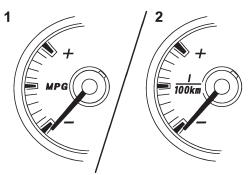ECO gauge

1) U.S.-spec. models
2) Except U.S.-spec. models
The ECO gauge shows the difference between the average rate of fuel consumption and the current rate of fuel consumption. Using the average rate of fuel consumption since the trip meter was last reset, the indicator needle behaves as described in the following items.
U.S.-spec. models:
If the current rate of fuel consumption is lower than the average rate of fuel consumption, the indicator needle points to the У+Ф side. If the current rate of fuel consumption is higher than the average rate of fuel consumption, the indicator needle points to the У−Ф side. When the indicator needle is pointing to the У+Ф side, it indicates fuel-efficient driving.
Except U.S.-spec. models:
If the current rate of fuel consumption is lower than the average rate of fuel consumption, the indicator needle points to the У−Ф side. If the current rate of fuel consumption is higher than the average rate of fuel consumption, the indicator needle points to the У+Ф side. When the indicator needle is pointing to the У−Ф side, it indicates fuel-efficient driving.
NOTE
● The ECO gauge shows only an approximate indication.
● After resetting the trip meter, the average rate of fuel consumption is not shown until driving 0.6 mile (1 km). Until that time, the ECO gauge does not operate.
See also:
Defrosting or defogging the windshield
To direct warm air to the windshield and front door windows:
1. Set the air inlet selection button to the OFF position.
2. Press the УФ button.
3. Turn the temperature control dial all the way to t ...
Satellite radio operation (if equipped)
To receive satellite radio, it is necessary to install the SUBARU genuine satellite
receiver for some models, and to enter into a contract with a satellite radio network
service such as УXMTM sate ...
Refueling in cold weather
To help prevent moisture from forming in the fuel system and the risk of its freezing, use of an antifreeze additive in the fuel tank is recommended during cold weather.
Use only additives that are s ...


